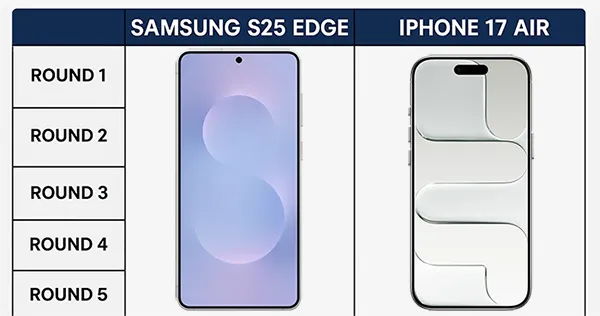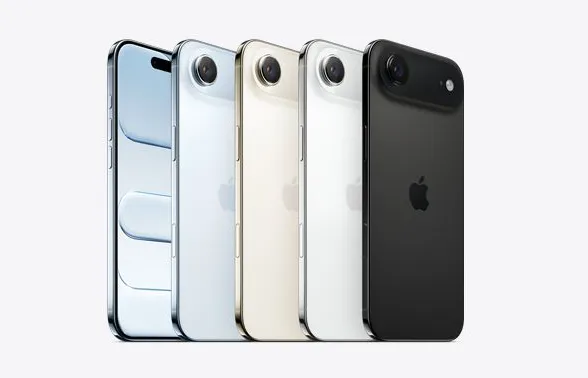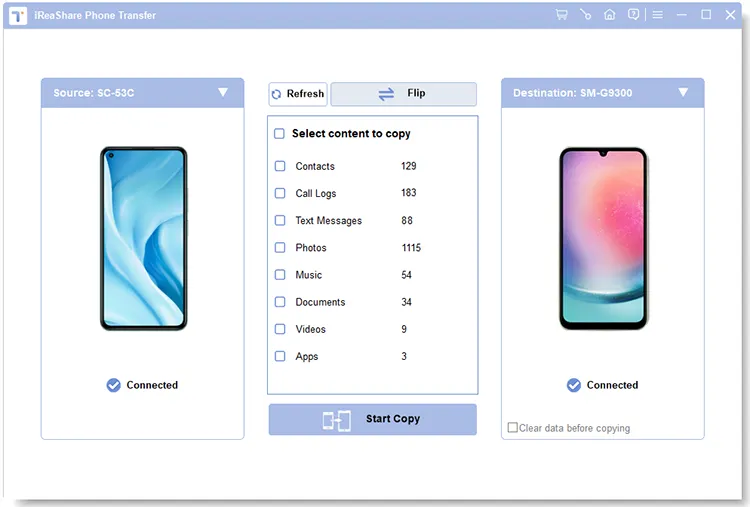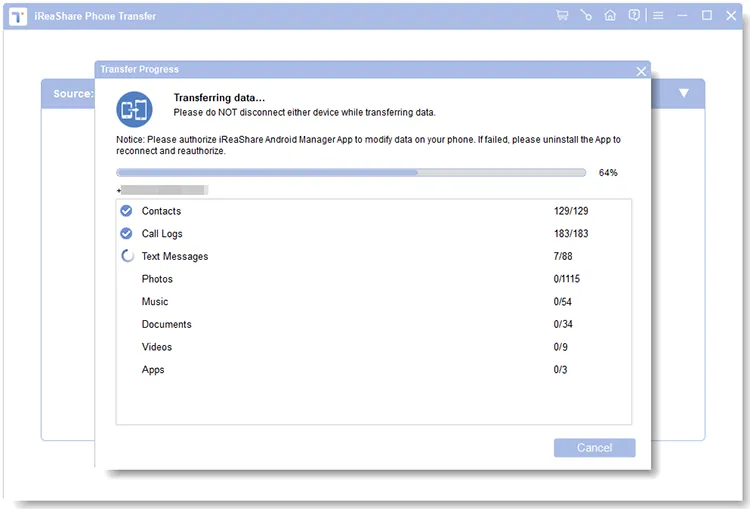When the iPhone 17 series has come out, the rivalry between Samsung and Apple is increasingly hot on the internet. As both companies continue to evolve their flagship devices, consumers are faced with tough decisions when choosing the best smartphone for their needs. In this article, we'll compare two of the most anticipated phones of the year: Samsung S25 Edge vs iPhone Air.
We'll break down the competition across various categories, from design and build quality to performance and camera systems. By the end, you'll have a clearer understanding of which phone best fits your preferences.

- Round 1: Samsung S25 Edge vs iPhone Air - Design and Build
- Round 2: Samsung S25 Edge vs iPhone 17 Air - Display
- Round 3: Galaxy S25 Edge vs iPhone Air - Performance
- Round 4: S25 Edge vs iPhone Air - Cameras
- Round 5: Samsung Galaxy S25 Edge vs iPhone Air - Battery and Charging
- Round 6: Galaxy S25 Edge vs iPhone 17 Air - Software and Ecosystem
- Round 7: Samsung S25 Edge vs iPhone Air - Price and Storage
- Bonus: Transfer Data to Your New Phone After Battle
Round 1: Samsung S25 Edge vs iPhone Air - Design and Build
Compare the design and build of S25 Edge and iPhone Air:
| Feature | Samsung Galaxy S25 Edge | iPhone Air |
|---|---|---|
| Thinness | 5.8mm, consistently thin. | 5.6mm, but only on the body. |
| Camera | A slimmer, unified camera bump that integrates into the back panel. | A prominent "camera plateau" that houses all major internal components. |
| Display | Larger 6.7-inch display with a small "hole-punch" cutout. | 6.5-inch display with a larger "Dynamic Island" cutout that is shifted down. |
| Overall Philosophy | A balanced, minimalist design that unifies components into a sleek, elegant form. | A radical, singular focus on making the main body as thin as possible, even at the cost of a pronounced camera module. |
1.1 Thickness and Weight
This is the most significant point of comparison for these specific models. The iPhone Air is 5.6mm thick and weighs 165g. The Samsung S25 Edge is 5.8mm thick and weighs 163g. The iPhone Air is thinner but the S25 Edge is lighter.
1.2 Materials
Both phones are described as having a titanium frame. The iPhone Air has Ceramic Shield 2 on the front and Ceramic Shield on the back. The S25 Edge has Corning Gorilla Glass Ceramic 2 on the front and Gorilla Glass Victus 2 on the back. Their protection materials both support Mohs level 5.
1.3 Aesthetics
When comparing the aesthetics of the Samsung Galaxy S25 Edge and the iPhone Air, it's clear that both phones are focused on a key design principle: achieving an ultra-thin profile. However, they go about it in different ways, leading to distinct aesthetic philosophies.
Samsung Galaxy S25 Edge: Minimalist and Unified
S25 Edge prioritizes a sleek, minimalist aesthetic that feels unified and seamless. The phone has a dual-camera system with a slimmer, more traditional camera "bump" that blends into the back panel. The camera module is designed to look like a unified structure with the rest of the phone.
The S25 Edge features a larger display with a smaller, more minimal "hole-punch" cutout for the front camera. This creates a more immersive, uninterrupted viewing experience. The display is slightly curved, a signature Samsung design element, which also contributes to a comfortable, one-handed grip.

iPhone Air: Radical and Focused
Apple's iPhone Air design is a more radical approach, making a dramatic compromise to achieve its impossible thinness.
The iPhone Air features a unique "camera plateau" instead of a traditional bump. This raised section on the back of the phone houses the entire camera system and most of the phone's internal components, allowing the rest of the chassis to be impossibly thin. While the rest of the phone is 5.6mm, this plateau protrudes significantly. This design choice is a bold statement, prioritizing the thinness of the main body at the expense of a flush back.
While the display itself is a high-quality Super Retina XDR panel, Apple had to shift the Dynamic Island and Face ID sensors down to accommodate the camera plateau's internal components. This means the pill-shaped camera cutout cuts deeper into the display, potentially obstructing content more than the S25 Edge's hole-punch.
The iPhone Air's aesthetic is defined by its extreme thinness, which is meant to be a sensory experience. The device feels like a "single slab of glass," with its rounded corners giving the illusion of being even slimmer.

Tips: It's important to back up your useful data on your old phone, preventing data loss after switching to a new device.
Round 2: Samsung S25 Edge vs iPhone 17 Air - Display
Take a quick look at the display of Samsung S25 Edge and iPhone Air:
| Feature | Samsung Galaxy S25 Edge | iPhone Air |
|---|---|---|
| Screen Size | 6.7 inches | 6.5 inches |
| Technology | Dynamic LTPO AMOLED 2X | Super Retina XDR OLED with ProMotion |
| Resolution | 1440 x 3120 pixels (QHD+) | 1260 x 2736 pixels |
| Pixel Density | ~513 ppi | ~460 ppi |
| Peak Brightness | ~2600 nits | ~3000 nits |
| Refresh Rate | 1-120Hz adaptive | 1-120Hz adaptive |
2.1 Screen Size and Technology
The Samsung Galaxy S25 Edge and the iPhone Air are both new entries in the ultra-premium smartphone market, and while they share a focus on slim design, their screen technologies and specifications are distinct.
The Galaxy S25 Edge features a large 6.7-inch display. This size makes it a great choice for media consumption and multitasking, offering a more expansive viewing area than many other flagship phones.
Samsung uses a Dynamic LTPO AMOLED 2X panel. This is a top-tier display technology that provides vibrant colors, deep blacks, and excellent contrast. The LTPO (low-temperature polycrystalline oxide) technology is crucial for power efficiency, allowing the phone's refresh rate to dynamically adjust from 1Hz to 120Hz.
The iPhone Air has a slightly smaller 6.5-inch display. While still a large screen, it's a bit more compact than the S25 Edge. Apple utilizes its Super Retina XDR OLED technology with ProMotion. Similar to Samsung's LTPO, ProMotion allows for an adaptive refresh rate, which can go up to 120Hz for smooth motion and down to 1Hz for static content to save battery.
2.2 Resolution and Brightness
The S25 Edge's display has a Quad HD+ resolution of 1440 x 3120 pixels, resulting in a very high pixel density of around 513 ppi. This delivers incredibly sharp and crisp visuals. Besides, the screen boasts a high peak brightness of up to 2600 nits, ensuring excellent visibility even in direct sunlight.
The iPhone Air's resolution is 1260 x 2736 pixels, which translates to a pixel density of approximately 460 ppi. While not as high as the S25 Edge, it is still well beyond what the human eye can typically distinguish at a normal viewing distance. It also boasts an impressive peak outdoor brightness of 3000 nits, which is a key advantage for outdoor visibility.
2.3 Display Features
The iPhone Air display has an anti-reflective coating, which the S25 Edge reportedly lacks. Both have HDR support (HDR10+ on Samsung, HDR10 and Dolby Vision on iPhone).
Round 3: Galaxy S25 Edge vs iPhone Air - Performance
Take a quick look at their performance:
| Feature | Samsung Galaxy S25 Edge | iPhone Air |
|---|---|---|
| Processor & RAM | ||
| Processor | Snapdragon 8 Elite for Galaxy | Apple A19 Pro |
| CPU Performance | Excellent multi-core, but single-core can be lower and variable under load. | Excellent single-core, but sustained performance may be limited by thermal throttling. |
| GPU Performance | High-end GPU performance, but can be susceptible to throttling. | Powerful 5-core GPU with next-level mobile gaming performance. |
| RAM | 12GB LPDDR5X | 12GB |
| AI Features | ||
| AI Platform | Galaxy AI (with Google Gemini) | Apple Intelligence (with on-device focus) |
| Core Philosophy | A wide-ranging, deeply integrated ecosystem with a strong partnership with Google. | Privacy-first, on-device intelligence for a seamless and secure experience. |
| Camera AI | ProVisual Engine for a more versatile camera system with tools like Audio Eraser and Super Resolution Zoom. | Relies on AI to enable features like "optical-quality" 2x zoom and next-gen portraits from a single lens. |
| Productivity | Circle to Search 2.0, Live Translate, and seamless multi-app actions. | Writing Tools for text rewriting and summarization, and Visual Intelligence. |
| Content Creation | Generative Edit in photos, Audio Eraser. | Genmoji, Clean Up for photos. |
| AI Performance | Powered by the Snapdragon 8 Elite for Galaxy with dedicated AI processing. | Powered by the A19 Pro with a new Neural Engine and Neural Accelerators built into the GPU. |
3.1 Processor
The S25 Edge is powered by the Snapdragon 8 Elite for Galaxy, a customized version of the latest flagship Qualcomm processor. It is built on a 3nm process and features an octa-core CPU. Initial benchmark results show a mixed bag, with multi-core scores that can occasionally surpass the iPhone Air, but single-core performance can be lower and more variable due to thermal throttling.
The iPhone Air features Apple's latest A19 Pro chip. This is the same chip found in the larger and more traditionally designed iPhone 17 Pro models. The A19 Pro boasts a new 6-core CPU and a 5-core GPU with built-in Neural Accelerators.
While initial benchmarks show a slight lead in single-core performance over the S25 Edge, some analysis suggests that its ultra-thin design may lead to more aggressive thermal throttling under sustained heavy workloads, potentially bringing its performance down to or even below the S25 Edge.
3.2 RAM
The S25 Edge comes with a generous 12GB of LPDDR5X RAM. This is a significant amount of memory, which is beneficial for multitasking and keeping many apps open without performance degradation. It also comes with either 256GB or 512GB of storage using the faster UFS 4.0 standard.
The iPhone Air also features 12GB of RAM, a substantial increase over previous non-Pro models and a reflection of the phone's premium positioning. Storage options range from 256GB to a maximum of 1TB. While Apple does not publicly specify the type of storage, it's generally known to be exceptionally fast.
3.3 AI Features
Samsung Galaxy S25 Edge: A Mature and Integrated AI Ecosystem
Samsung has built upon its "Galaxy AI" suite, which is deeply integrated into the S25 Edge's software (One UI 7). Its AI features are a collaboration between Samsung's own innovations and Google's powerful Gemini models.
Circle to Search 2.0 is a standout feature that allows you to circle, tap, or scribble on anything on your screen to get search results instantly. The new version is even smarter, capable of recognizing and acting on things like phone numbers and links.
The S25 Edge's AI-powered camera system uses a "ProVisual Engine" to enhance photo quality. Features include:
- AI Super Resolution Zoom: Enhances clarity when zooming in.
- Audio Eraser: An AI tool that lets you remove unwanted background noise from your videos.
- ProScaler Imaging: Boosts image scaling and quality by 40%.
Galaxy AI is also designed to make daily tasks easier:
- Now Brief and Now Bar: Provide personalized, live content feeds and quick access to controls.
- Live Translation: Automatically translates texts and phone calls in real time.
- Seamless Actions: Allows you to use voice commands with Google's Gemini to perform multi-step tasks across various apps.
Samsung Knox Vault, a secure processor and memory chip, isolates sensitive data like passwords and biometrics, providing an extra layer of on-device security for AI features.
iPhone Air: On-Device Intelligence with a Focus on Privacy
Apple's AI capabilities, branded as "Apple Intelligence," are deeply tied to iOS 26 and the A19 Pro chip. A key pillar of Apple's approach is on-device processing, which ensures user data remains private and AI features can work offline.
Apple Intelligence focuses heavily on creation and communication:
- Genmoji: A fun feature that lets you create a custom emoji with a simple text description.
- Writing Tools: AI features are integrated into the keyboard to help you proofread, rewrite text with a different tone, or summarize selected content.
- Clean Up: An AI photo editing tool that lets you remove unwanted objects and distractions from your photos while preserving the original quality.
Visual Intelligence feature allows you to search, ask questions, and take actions based on the content on your iPhone screen, similar to Google's capabilities on Samsung devices.
The iPhone Air's single 48MP "Fusion" camera relies heavily on AI to perform tasks that would normally require multiple lenses. It can create next-generation portraits by intelligently capturing depth information and supports "Dual Capture", which lets you record with the front and rear cameras simultaneously.
Besides, Apple's Live Translation provides real-time translation for texts and spoken words in FaceTime and phone calls. What's more, a smart AI feature in iOS 26 that learns a user's habits to intelligently conserve power when needed.
Read more: Want to reset your old iPhone? Can the resetting delete everything on the old device? Open the link to find out the answer.
Round 4: S25 Edge vs iPhone Air - Cameras
This is a quick comparison of the cameras of Samsung S25 Edge and iPhone Air:
| Feature | Samsung Galaxy S25 Edge | iPhone Air |
|---|---|---|
| Rear Camera System | Dual Camera: 200MP Main (2x optical-quality zoom), 12MP Ultrawide | Dual Camera: 48MP Main (2x optical-quality zoom), 12MP Telephoto |
| Front Camera | 12MP with PDAF | 18MP "Center Stage" with a square sensor for intelligent framing and wider shots. |
| Video Capabilities | Up to 8K at 30fps, 4K at 120fps, with AI Audio Eraser. | Up to 4K at 60fps with Dolby Vision, Dual Capture, and Action Mode. |
| Camera Philosophy | Leans on a massive main sensor and AI processing to make up for a missing telephoto lens. | Uses a single, powerful "Fusion" system and advanced AI to achieve professional-grade results from a more limited hardware array. |
4.1 Rear Camera System
To achieve its slim profile, the S25 Edge forgoes a dedicated telephoto lens, which is a major compromise for a flagship phone. Instead, it relies on a powerful 200MP main sensor (the same as the Galaxy S25 Ultra) to provide zoom capabilities.
Galaxy S25 Edge offers a 2x optical-quality zoom by cropping a native region of the sensor, and a digital zoom of up to 10x. This is a notable departure from the multi-lens systems found on other flagships. It also includes a 12MP ultrawide camera with autofocus, which supports macro photography.
iPhone Air has taken a more innovative approach, creating a "Fusion Camera System" that houses multiple capabilities in a single, large camera module. It features a 48MP main camera and a 12MP telephoto lens.
The rear camera system of iPhone Air is powered by the A19 Pro chip's advanced image signal processor (ISP) and Neural Engine. It can intelligently combine data from the sensors to produce what Apple calls an "optical-quality" 2x zoom. The phone also supports "next-generation portraits" by automatically capturing depth information, allowing you to adjust the focus after the photo is taken.
4.2 Front Camera
The S25 Edge has a 12MP front-facing camera with dual-pixel PDAF, offering reliable and high-quality selfies and video calls. Its front camera is largely a carry-over from previous models, but it benefits from the new "ProVisual Engine" for improved processing.
The iPhone Air introduces a new 18MP "Center Stage" front camera. This is a significant upgrade in resolution and is designed with a new, larger square sensor. This unique design allows it to intelligently crop and reframe shots to maintain a person in the center of the frame during video calls and even switch from a vertical to a landscape orientation for group selfies without you having to physically turn the phone.
4.3 Video Capabilities
The S25 Edge is a powerhouse for video, supporting up to 8K video recording at 30fps. It also offers a variety of frame rates at lower resolutions, including 4K at up to 120fps. A new "Audio Eraser" feature uses AI to let you remove unwanted background noise from your videos after they've been recorded.
The iPhone 17 Air offers a more focused but equally powerful video experience. It supports 4K video recording at 60fps with Dolby Vision and includes professional-grade features like Action Mode for advanced stabilization. A key new feature is "Dual Capture," which allows you to record with both the front and rear cameras simultaneously.
Round 5: Samsung Galaxy S25 Edge vs iPhone Air - Battery and Charging
Quickly compare the battery and charging of Galaxy S25 Edge and iPhone Air:
| Feature | Samsung Galaxy S25 Edge | iPhone Air |
|---|---|---|
| Battery Capacity | 3,900 mAh | 3,149 mAh |
| Wired Charging | 25W (55% in ~30 min) | 20W (50% in ~30 min) |
| Wireless Charging | 15W Qi/Qi2 | 20W MagSafe/Qi2 |
| Standout Feature | Wireless PowerShare | More efficient power management and slightly faster wireless charging. |
5.1 Battery Capacity
The S25 Edge has a relatively small 3,900 mAh battery. This is a considerable decrease from the 4,900 mAh battery in the larger Galaxy S25+ and a clear trade-off for its ultra-thin 5.8mm profile. While Samsung's software and the efficient Snapdragon 8 Elite for Galaxy chip help, this smaller battery capacity means that heavy users may struggle to get a full day's use without needing to top up.
Despite being even thinner at 5.6mm, the iPhone Air reportedly features a 3,149 mAh battery. While this number is smaller than the S25 Edge's, Apple leverages its tight integration of hardware and software to maximize endurance. The highly efficient A19 Pro chip, an adaptive display that can drop to 1Hz, and an "Adaptive Power Mode" in iOS 26 all work together to deliver what Apple claims is "all-day battery life".
5.2 Wired Charging
The Galaxy S25 Edge supports 25W wired charging. This is a conservative speed for a modern flagship, especially when compared to some Android rivals that offer 100W or more. Samsung's marketing for this feature promises a charge of up to 55% in around 30 minutes, which is a respectable but not a record-breaking speed. The phone does not ship with a charger in the box.
The iPhone Air supports 20W wired charging. This speed, while not as fast as some of the higher-end iPhones, is sufficient to get a 50% charge in about 30 minutes, which is comparable to the S25 Edge. Apple has historically prioritized battery health over raw charging speed, and the iPhone Air's performance in this area aligns with that philosophy.
5.3 Wireless Charging
The Samsung S25 Edge supports 15W Qi wireless charging and is Qi2-certified, meaning it includes a magnetic ring for precise alignment with compatible chargers. It also supports Wireless PowerShare, allowing it to wirelessly charge other devices like earbuds or smartwatches.
Apple has a slight edge in wireless charging speed, with the iPhone Air supporting 20W wireless charging via MagSafe and Qi2. This is a significant bump from the 15W of previous models and gives it a clear advantage in a world of ever-increasing wireless convenience.
Round 6: Galaxy S25 Edge vs iPhone 17 Air - Software and Ecosystem
Have a quick look at the software and ecosystem of S25 Edge and iPhone Air:
| Feature | Samsung Galaxy S25 Edge | iPhone Air |
|---|---|---|
| Operating System | Android 16 with One UI 8 | iOS 26 |
| Ecosystem | Samsung Galaxy Ecosystem (watches, buds, tablets) and deep integration with Windows. | Apple Ecosystem (Mac, iPad, Apple Watch) with seamless, proprietary features. |
| Software Philosophy | Highly customizable, feature-rich, and open. | Simple, intuitive, and tightly integrated. |
| Software Support | 7 major OS updates and 7 years of security patches. | 5+ years of major iOS updates and longer for security patches. |
6.1 Operating System
The S25 Edge runs on Android 16 with Samsung's custom One UI 8 skin on top. One UI is known for its extensive customization options, including a wide range of themes, icon packs, and a highly flexible home screen. It also features a robust multitasking system with split-screen and floating windows.
Samsung's software has evolved to be highly functional, with features like the Now Bar and a revamped notification shade. The core Android experience is heavily overlaid with Samsung's own apps and services, creating a distinct user experience.
The iPhone Air ships with iOS 26. Apple's operating system is known for its simplicity, polish, and tight integration with the hardware. iOS offers a more curated and less customizable experience than Android, which many users find more intuitive and straightforward.
The new "Liquid Glass" design language in iOS 26 gives the UI a translucent, fluid appearance. Key features in iOS 26 include a redesigned Photos app, a dedicated Passwords app, and new communication tools.
6.2 Ecosystem
The Samsung S25 Edge is the central hub of Samsung's "Galaxy Ecosystem". This includes a wide range of devices such as Galaxy Watches, Galaxy Buds, and Samsung's own line of tablets and laptops. Samsung also has a strong partnership with Microsoft, enabling seamless integration with Windows PCs through features like Quick Share and Link to Windows.
The open nature of the Android ecosystem means the S25 Edge can also work with a vast array of third-party devices and services, from smart home gadgets to car infotainment systems.
The iPhone Air is an integral part of the "Apple Ecosystem", which is famous for its seamless and deeply integrated experience. Features like Handoff, AirDrop, and Universal Control allow for effortless communication and file sharing between the iPhone, a Mac, an iPad, and an Apple Watch.
Apple's ecosystem is more tightly controlled, ensuring a high degree of security and privacy, but it can be less flexible with non-Apple products. A key new feature is "iPhone Mirroring on Mac", allowing full control of your iPhone from your desktop.
6.3 Software Support
Samsung has committed to a leading software support policy for its flagship devices. The S25 Edge is promised seven years of major Android OS updates and seven years of security patches. This is a significant commitment that matches Apple's long-standing reputation for software longevity and gives the S25 Edge excellent future-proofing.
Apple's software support is historically unmatched in the industry, though they do not provide a specific number of years. The iPhone Air is expected to receive major iOS updates for at least five to seven years, and security updates for even longer. This ensures that even years down the road, the iPhone Air will have the latest features and security protections.
Round 7: Samsung S25 Edge vs iPhone Air - Price and Storage
Compare the pricing and storage of S25 Edge and iPhone Air:
| Feature | Samsung Galaxy S25 Edge | iPhone Air |
|---|---|---|
| Starting Price | $1,099.99 | $999.99 |
| Storage Options | 256GB, 512GB | 256GB, 512GB, 1TB |
| Pricing Strategy | Positioned as a high-end alternative between the standard and Ultra models. | An entirely new premium tier that is more accessible than the Pro models. |
| Key Difference | Limited to two storage options. | Offers a 1TB option for maximum storage. |
7.1 Starting Price
The Samsung Galaxy S25 Edge is positioned as a high-end device, slotting in between the standard Galaxy S25 and the top-of-the-line S25 Ultra. The starting price for the 256GB model is around $1,099.99. This price point positions it directly against Apple's premium offerings.
The iPhone Air is an entirely new product in Apple's lineup and is also a premium offering. Its starting price for the base 256GB model is $999.99. This is a strategic price point that is higher than the standard iPhone 17 but is slightly more accessible than the S25 Edge and the Pro models, making it an attractive option for those who prioritize design and a premium feel.
7.2 Storage Options
To match its premium positioning, the S25 Edge starts with a generous amount of storage. The two available options are:
- 256GB (base model)
- 512GB
Samsung's decision to skip a 128GB option on its high-end device simplifies the lineup and ensures users have ample space for apps, photos, and videos.
Apple has made a similar choice with the iPhone Air, starting with a higher base storage capacity. The available options are:
- 256GB (base model)
- 512GB
- 1TB
The inclusion of a 1TB option on the iPhone Air provides an impressive amount of storage for users who need to store a vast amount of data, such as high-resolution videos, large photo libraries, and extensive app collections.
Bonus: Transfer Data to Your New Phone After Battle
After the battle is over and you've made your decision, the next challenge is getting all your data from your old phone to your new one. This is where a tool like iReaShare Phone Transfer becomes a lifesaver. This software is a direct data migration tool for iOS and Android devices. You can use it to effortlessly transfer your data from one phone to your Samsung Galaxy S25 Edge or your iPhone Air.
Main features of iReaShare Phone Transfer:
* Simplify the process into three easy steps: connect devices, select data, and start.
* Handle a wide range of data types, including contacts, SMS messages, photos, videos, music, call history, apps, eBooks, etc.
* Allow you to move data from a Samsung phone to an iPhone and vice versa.
* Transfer files directly between devices via USB, ensuring the process is fast, secure, and free from internet dependency or data loss.
* Also support Wi-Fi transfer between Android devices.
* Compatible with Android 6.0 or later, and iOS 5.0 or higher, including Android 16 and iOS 26.
Download iReaShare Phone Transfer.
Download for Win Download for Mac
To transfer data from one smartphone to your new S25 Edge or iPhone Air:
-
Connect your old and new smartphones to your computer with their USB cables. Then install the Phone Transfer software on the computer.
-
Launch the program, and enable USB debugging on Android. For iOS, click "Trust" on the iPhone. Then make sure your new phone is the "Destination" device. Or you can click "Flip".

-
Select the data types you want to transfer, and click "Start Copy" to begin transferring the data to your new phone.

Watch the video tutorial to transfer your data:
Conclusion
Choosing between the Samsung Galaxy S25 Edge and the iPhone Air is a matter of prioritizing what you value most—be it camera versatility, display brightness, or ecosystem integration. But no matter which champion you choose, iReaShare Phone Transfer is the tool that ensures a smooth and secure transition to your new device.
Download for Win Download for Mac
Related Articles
Samsung Contacts Backup: Easily Back Up Samsung Contacts via 5 Methods
How to Transfer Music from iPhone to Android [Detailed Guide]
How to Transfer Files from PC to iPhone Easily (8 Useful Solutions)





























































